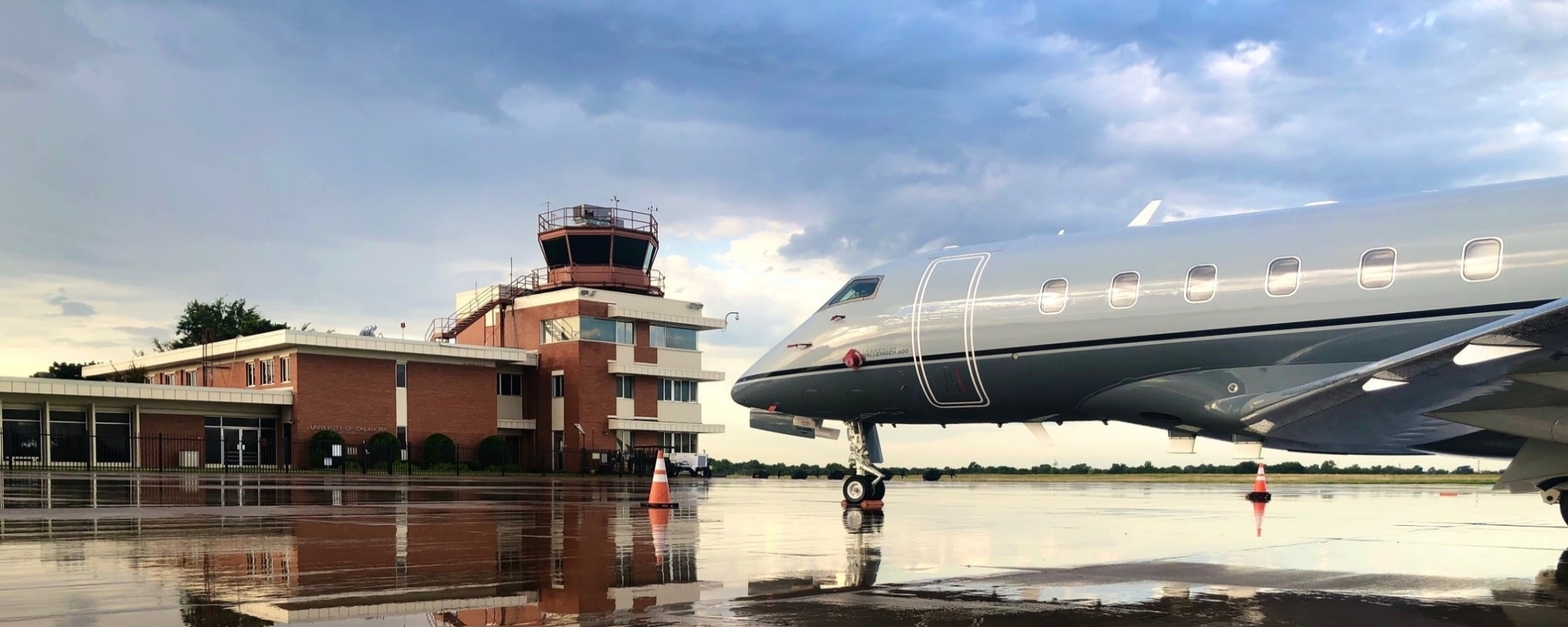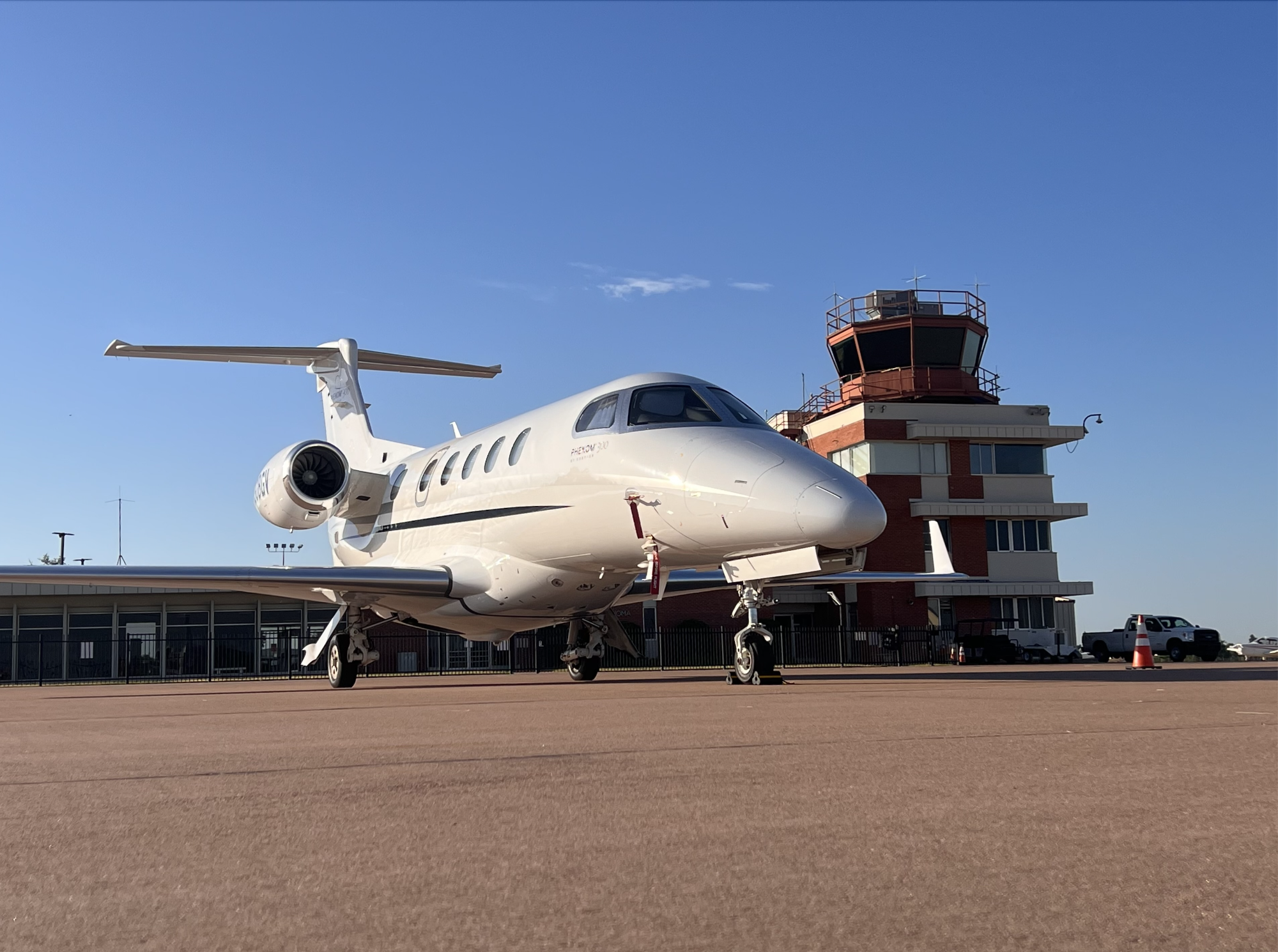
Come extend a warm welcome, Norman style, to the OK Diner. The restaurant is open from 7:00am-2:00pm Tuesday through Sunday, and closed on Mondays. Please visit the link below for more information on the OK Diner.

The Vision of the University of Oklahoma Max Westheimer Airport is to become a premier destination for general aviation and business aviation in the state of Oklahoma while supporting education, research, the local economy, and the community.
The Mission of the University of Oklahoma Max Westheimer Airport is to provide general and business aviation with a safe, professional, and effective facility while contributing to education, research, and generating economic benefit by acting as a gateway to The University of Oklahoma, The City of Norman, and South-Central Oklahoma.
Oklahoma’s clear blue skies have beckoned aviators at The University of Oklahoma for many years. As early as the fall of 1927, a group of students interested in an advanced aeronautical study organized Tau Omega, an aviation fraternity that established the first flying school at Norman in a small pasture unsuitable for use as a flying field. Nevertheless, the school, completely unaffiliated with the University, stimulated interest among both students and faculty members. In early 1940, the regents created a University flight training program. From those meager beginnings developed complete coursework in airplane design and mechanics as well as airport management that exists to this day.
In the fall of 1940, aviation took a big stride forward at the University of Oklahoma when a gift of $10,500 from the estate of the late Max Westheimer of Ardmore was given to OU to purchase 160 acres northwest of Norman for a flying field. Walter Neustadt, Sr. of Ardmore announced the gift as a memorial to Mr. Westheimer, his father-in-law. The city of Norman voted bonds to purchase the adjacent 128 acres needed to complete the field. In October 1941, the University leased the city land for 99 years at $1 a year. Within a few weeks, a grass landing strip was in use on a flat Oklahoma plain that soon became known as the Max Westheimer Field.
Less than two months later, Japanese planes peeled out of the skies to bomb Pearl Harbor, a port for the U.S. Pacific fleet. Looking for ways that the University could help in the war effort, Savoie Lottinville, director of the OU Press, serendipitously visited with a Navy captain on a train. Questioned about the interest in flying at the University, Lottinville told the captain about the newly completed Max Westheimer Field. The captain asked, “Would you be willing to lend it to the Navy for the duration of the war?” After talking with The University of Oklahoma President Joseph A. Brandt, Lottinville went to Washington, D.C., where a tentative agreement was reached with the Navy for the wartime use of Max Westheimer Field.
Max Westheimer Field was operated by the University scarcely for one year before the Navy moved in, took the field over as an emergency measure and quickly expanded it. During this time, the station graduated 6,461 cadets and 2,500 others received flight instruction. The facility was further developed in 1945, resulting from federal funds allocated to WPA for national defense purposes which were matched by funds furnished by OU and a City of Norman bond issue. Declared by the U.S. War Department to be of military necessity, the field met the Class 3 airport requirements of the Civil Aeronautics Authority.
The Naval Air Station was converted back to its educational role in May 1946, after approximately four years of operation by the Navy. Shortly after the war’s end, the airport was deeded back to OU by the War Assets Administration. That same year, Joe Coulter, chairman of the department of aeronautics, took over as longtime director, eventually adding new courses and central tower operation. The flying field continued as a training ground for students enrolled in the Civilian Pilot Training program and provided a base where pilots were stationed by the federal government for national defense purposes.
During the “Air Age,” the University realized that its responsibility to the promotion of aviation was not limited to the mere operation of an airport; being an educational institution, the University worked to improve the field of aviation education. In 1946, the University planned its first aeronautical engineering course, giving basic training for the various engineering specialties and requiring flight instruction up to the level of a private pilot license. The second was a course in airport management taught in the College of Business Administration.
Besides the hundreds of students who learned to fly in regular University operated classes, the desire to take wing spread to the administration as well. In 1949, the year a tornado hit the airport and swept a great deal of it away, OU President George L. Cross learned to fly in the very short time of 26 days and soloed at Westheimer Field. Alumni and other guests attending football games in Norman began to land at the University’s own airport. On any given gridiron weekend, 100 to 200 visiting planes could be found in the field.
W.L. Wardell, coordinator of University-sponsored WPA projects said, “There is no university which has an airport that will be equal to this one when it is developed according to the present plan.” Sure enough, by the late 1950s, Max Westheimer Field was the world’s largest university-owned airport, with four concrete runways, a central building, a tower, hangars, and a cafeteria.
Famous people who have trained at Westheimer include Shannon Lucid, NASA mission specialist, Robert Ragozzino, who flew around the world to 22 countries in 170 days in a Stearman biplane, and Gene Nora Jessen, a member of the Mercury 13 crew and trained students as a flight instructor for The University of Oklahoma.
In 1982, with the help of increasing oil & gas royalties, an operating control tower was established when the University hired four retired military controllers. As traffic increased, the need for a larger control tower was obtained from Tinker Air Force Base and placed atop the current terminal building. The renovation took place and in June of 1986, the Westheimer Control Tower was opened.
Today, Max Westheimer is home to seven aviation businesses, approximately 68 hangar tenants, and over 110+ based aircraft. As many as 100 students a year complete their private pilot certificates through the University of Oklahoma School of Aviation. Yearly another 1000+ children can obtain hands-on experience in the aviation field each summer through the Sooner Flight Academy program. Each year an estimated 20,000 visitors arrive in Oklahoma by utilizing Max Westheimer Airport. Allowing the airport to contribute an estimated $34.7 million dollars of economic activity to the surrounding community. This economic impact comes from jobs, annual payroll, annual spending, and sales tax paid by visitors.
Click here to learn more about the Max Westheimer Airport during WWII.

Max Westheimer Airport, owned and operated by the University of Oklahoma, is an integral component of the transportation infrastructure serving the city of Norman and the surrounding region. The airport, along with the surrounding property and complex of existing and planned activities, represents a significant regional economic asset.
Each year an estimated 20,000 visitors arrive in Oklahoma by utilizing Max Westheimer Airport. The airport contributes an estimated $34.7 million dollars of economic activity to the surrounding community. This economic impact comes from jobs, annual payroll, annual spending, and sales tax paid by visitors on hotels, meals, rental cars, and retail spending. The Airport also supports several state law enforcement agencies which include Oklahoma Highway Patrol and the Oklahoma Bureau of Narcotics.
Max Westheimer Airport is classified by the Oklahoma Aeronautics Commission as a Regional Business Airport servicing general aviation aircraft, including business jets. The airport is also designated by the FAA as a General Aviation Reliever Airport for Will Rogers World Airport in Oklahoma City, which is the primary commercial airport serving the Oklahoma City metropolitan area and the region.
Westheimer Airport has a staffed control tower, instrument landing system, and an Automated Weather Observation System with thunderstorm and lightning detecting in order to serve the needs of businesses, recreational pilots, and OU students and staff. Westheimer is a full-service airport, with 120 based aircraft and handles more than 50,000 operations per year.